Dear WesleyNexus Colleague:
Several days ago, many people around the world were treated to a shower of “shooting stars,” an event that scientists identify as the Perseid meteor shower. In fact, 2018 was an excellent year for observation, because the new moon of August arrived on Saturday the 11th this year, perfectly timed to bring dark, moonless nights at the shower peak period. The earth passed through the shower’s richest display about 9:00 pm Eastern time on Sunday August 12
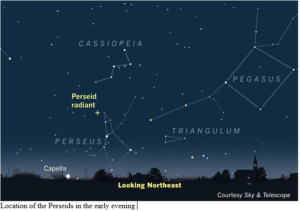 The Perseids no longer hold the title of the “most prolific” of the annual meteor displays; the December Geminids now produce meteors in greater numbers. But the Perseids are still the most popular because they appear during balmy summer nights as opposed to the wintry Geminids. Of course, the Perseids are not stars dropping from their fixed positions in the sky. Rather, they are tiny flecks of material that were shed by Comet Swift-Tuttle each time it swept past the sun. Comet Swift-Tuttle was discovered during the summer of 1862 by Lewis Swift, an amateur astronomer based in New York, and Horace Tuttle, a professional astronomer at the Harvard College Observatory. The comet has an orbital period of roughly 130 years and was last sighted in December 1992. Its next expected return is slated for August 2126.
The Perseids no longer hold the title of the “most prolific” of the annual meteor displays; the December Geminids now produce meteors in greater numbers. But the Perseids are still the most popular because they appear during balmy summer nights as opposed to the wintry Geminids. Of course, the Perseids are not stars dropping from their fixed positions in the sky. Rather, they are tiny flecks of material that were shed by Comet Swift-Tuttle each time it swept past the sun. Comet Swift-Tuttle was discovered during the summer of 1862 by Lewis Swift, an amateur astronomer based in New York, and Horace Tuttle, a professional astronomer at the Harvard College Observatory. The comet has an orbital period of roughly 130 years and was last sighted in December 1992. Its next expected return is slated for August 2126.
The comet has likely circled the sun many hundreds of times and has left a “river of rubble” in its wake. Because the respective orbits of Earth and Comet Swift-Tuttle nearly coincide in the middle of August, Earth ends up sweeping through this rubble river. As we plow through the debris field, these tiny pieces of comet dust ram through the upper atmosphere at 37 miles per second. Friction with the atmosphere raises these particles to white heat and produces an incandescent trail of ionized gas, which leads to the “shooting star” effect.
This is one of the wonders of the natural world, and the science of astronomy has provided us with a thorough and accurate description of this phenomenon. That is an excellent example of what science does. But we were wondering – what did the ancients conclude about this phenomenon when they observed these flecks of light streaming through the sky? Of course, “shooting stars” was one such conclusion, but others would have attributed this phenomenon to divine activity, perhaps some conflict or battle among the gods? Who could blame them?
This common-sense interpretation of heavenly activity would reflect widespread credence, because in the ancient world, everyone knew that the heavens were the abode of the gods. Those of us on earth lived in a three-tiered universe – the heavens above, the earth in the middle and then the waters below the earth, the realm of the dead and demons. And, moreover, their cosmology provided the framework for their theology.
You can see this is the Genesis story and in the stories told by other cultures across the ancient world. The principle is the same everywhere: cosmology shapes theology. Which raises a question for us. Given our knowledge of the expanding universe that is 13.7 billion years old, and our place somewhere in the mid-range of the “milky way” galaxy – itself one of millions or billions of galaxies, made up of billions of stars – what does this mean for our theology? Surely it makes no sense to speak of a “god up there” who “looks down on us” and occasionally lifts a finger on our behalf. So why do we persist, in our bible stories to children and in our sermons, in speaking this way? The answer is that we may be too lazy to think about alternatives. We at WesleyNexus believe it is time that we wake up to the challenge before us. Our young people have left the myths of the past behind, and reject the language of the ancients. But they have no way, no resources, with which they might fashion a coherent theology for the present and future.
Into the void steps the new myth makers, the screen-writers who give us Star Wars and Star Trek and Guardians of the Galaxy – all fighting the battles of the Wild West. All of us – not just our young people – are caught up in these images and epics, and we can even find traces of timeless truths, and religious values, and heroic qualities that deserve attention and respect. We can even find important “teaching moments” in the epic when Anakin Skywalker sacrifices his life for his son, Luke. We can easily connect the wisdom of the Jedi sages to the wisdom of the Hebrew prophets, and find Christian themes in the relationships of the rebel alliance.
But none of this builds a theology for the post-modern age in which we live. The Force is not the God of the Bible, but we have no clue as to how we might make the God of the Bible relevant for our age.
Of course, there are some among us who are working on that project. One such is theologian Dr. John Haught, whose newest book The New Cosmic Story: Inside Our Awakening Universe (Yale, 2017), offers a coherent framework within which we are called to theologize for our time. In this book, Haught provides an antidote to the pessimism that prevails in some circles concerning the human future, and lays out a positive trajectory that refreshes our theological conversation. As physicist Kathleen Duffy says, Haught “transforms the universe of Big History into an evolving cosmos with heart and mind.”
Americans have now been introduced to our ten new astronauts who will, each in turn, travel up to the international space station, from which we will undoubtedly receive annual Christmas messages and enjoy cosmic new year celebrations. But that doesn’t satisfy our human yearning for meaning.
WesleyNexus will be sponsoring a series of talks in the Washington area in the month of September (see below) featuring Dr. Jack Haught, and we invite all of our colleagues in the science and religion dialogue to join us for these presentations. Our task to theologize in the 21st century is a huge one, but it is not formidable. Dr. Haught’s challenging insights draw us forward on the great adventure of participating in the awakening universe, a bold and compelling vision of hope on the basis of which we might rekindle the fires of our faith.
We appreciate the contributions we have received throughout the year. We used most of our funds presenting our Evolution Weekend program on February 11, making it available as a live video feed and recording it so those unable to attend can view it at their leisure. Looking forward, we will continue to develop programs throughout 2018. We will need your support and hope you will consider helping us out. WesleyNexus is a 501(c)(3) charitable, educational organization, and we will acknowledge all gifts from individuals for tax reporting purposes.
Thanks in advance for your support.
God Bless,
Rick, Maynard, and the rest of the
WesleyNexus Board of Directors
*********************************
Dr. Haught speaks at Potomac United Methodist Church, September 22nd
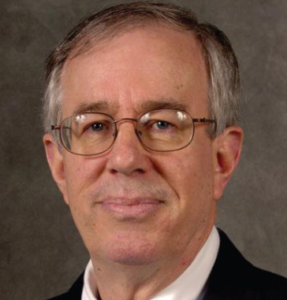 Dr. John Haught, emeritus professor of theology at Georgetown University, is a long-time member of the WesleyNexus Advisory Board, and will be visiting the greater Washington area in September. He will be keynoting the fall meeting of faculty for the member institutions of the Washington Theological Consortium, being hosted this year by Wesley Theological Seminary. In conjunction with WesleyNexus, the Potomac United Methodist Church (9908 South Glen Road – at the corner of Democracy and Falls Road — Potomac, MD) will be hosting Dr. Haught in a public forum on September 22, beginning at 9:30 a.m. and dismissing at noon. This will be a compelling illustrated presentation of the ideas that are so important for contemporary Christians, developed in his new book, The New Cosmic Story: Inside Our Awakening Universe (Yale, 2017, ISBN: 9780300-217032). There will be an opportunity for questions, answers and dialogue, coordinated by Dr. Laura Easto Blauvelt, so all are welcome.
Dr. John Haught, emeritus professor of theology at Georgetown University, is a long-time member of the WesleyNexus Advisory Board, and will be visiting the greater Washington area in September. He will be keynoting the fall meeting of faculty for the member institutions of the Washington Theological Consortium, being hosted this year by Wesley Theological Seminary. In conjunction with WesleyNexus, the Potomac United Methodist Church (9908 South Glen Road – at the corner of Democracy and Falls Road — Potomac, MD) will be hosting Dr. Haught in a public forum on September 22, beginning at 9:30 a.m. and dismissing at noon. This will be a compelling illustrated presentation of the ideas that are so important for contemporary Christians, developed in his new book, The New Cosmic Story: Inside Our Awakening Universe (Yale, 2017, ISBN: 9780300-217032). There will be an opportunity for questions, answers and dialogue, coordinated by Dr. Laura Easto Blauvelt, so all are welcome.
*********************************
The New Cosmic Story | Robert Wright & John Haught [The Wright Show]
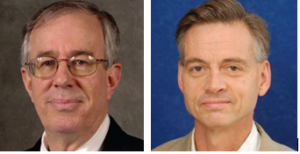
While we hope that everyone who is able will attend the program at Potomac United Methodist Church mentioned above, we realize that most will not be able to participate. The interview by Robert Wright presents the next best thing. Conducted in July of 2018, this interview with John Haught covers his most recent book in a wonderfully conversational manner and provides a broad and accessible summary of John Haught’s current thinking. Focusing on the secular notion of big history, Haught points out that this concept too often omits a profoundly significant feature of the universe, subjectivity. Given the Wesleyan affirmation of personal experience as a foundation to faith, this insight of Haught’s is of particular importance to us. Below you will find the topic areas covered in the interview which can be found here.
01:01 John’s book, The New Cosmic Story
07:27 Pierre Teilhard de Chardin and cosmic evolution
16:29 What it means to say that “God is more Omega than Alpha”
21:44 John: We live in an “awakening universe”
27:28 Putting religion in cosmic context
40:16 Does“rightness”exist apart from human judgment?
45:34 Why John takes comfort in the“unfinishedness”of the universe
49:52 Alfred North Whitehead’s influence on John’s worldview
57:26 Why John rejects Perennialism
https://www.youtube.com/watch?v=FGjsHNVbls0
*********************************
Quotes from John Haught
John Haught has been influential in the promotion of science and religion for well over two decades. He is currently on the WesleyNexus Advisory Board but his relationship with our group dates back well before its incorporation. Dr. Haught has been a regular presenter at the Washington Theological Consortium’s Science and Religion discussion group and has participated in programs at Metropolitan United Methodist Church in Washington, DC and at Grace United Methodist Church in Gaithersburg, MD. A prolific author, he has produced well over a dozen books during his career. We have chosen texts from seven of those books below that give a representative sample of some of the ideas articulated in those writings. These books in particular have impacted us at WesleyNexus, starting with What is God (1986) to the most recent The New Cosmic Story (2017). We hope you find these quotes instructive, taking some time to reflect.
The New Cosmic Story: Inside Our Awakening Universe (2017)
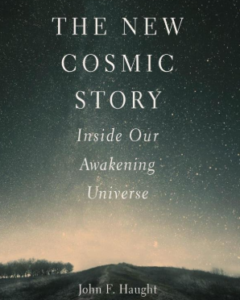 Religious experience is part of the inside story of the universe. For thousands of years religious sentiments have come down from one human generation to the next, packaged in symbolic forms whose meaning is mostly inaccessible to science. Yet the emergence of religious subjectivity, though hidden, is just as much part of the universe as is the formation of atoms and galaxies. Big History, following the methods of the physical sciences, characteristically pays little serious attention to religion and other things going on inside. My objective here then is to look inside the story of the universe without ignoring the outside. I am convinced that any big history that lives up to its name needs to correlate what is going on objectively with what is going on subjectively. (p. 2)
Religious experience is part of the inside story of the universe. For thousands of years religious sentiments have come down from one human generation to the next, packaged in symbolic forms whose meaning is mostly inaccessible to science. Yet the emergence of religious subjectivity, though hidden, is just as much part of the universe as is the formation of atoms and galaxies. Big History, following the methods of the physical sciences, characteristically pays little serious attention to religion and other things going on inside. My objective here then is to look inside the story of the universe without ignoring the outside. I am convinced that any big history that lives up to its name needs to correlate what is going on objectively with what is going on subjectively. (p. 2)
Making Sense of Evolution: Darwin, God, and the Drama of Life (2010)
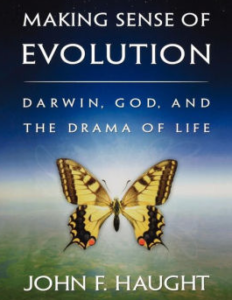 Evolutionary science invites theology to entertain the thought that a transformative drama had already been going on in the universe long before human beings arrived on the scene. That we have the backing of a universe-in-the-making can give substance to our hopes, and energy to our moral aspirations. Evolution helps Christian theology read the evangelical proclamation of a new creation with the spirit of adventure that it might not otherwise have. This is why a theological encounter with Darwin is so important for the renewal of Christianity today. (p. 147)
Evolutionary science invites theology to entertain the thought that a transformative drama had already been going on in the universe long before human beings arrived on the scene. That we have the backing of a universe-in-the-making can give substance to our hopes, and energy to our moral aspirations. Evolution helps Christian theology read the evangelical proclamation of a new creation with the spirit of adventure that it might not otherwise have. This is why a theological encounter with Darwin is so important for the renewal of Christianity today. (p. 147)
Is Nature Enough?: Meaning and Truth in the Age of Science (2006)
Try to imagine the alternatives. An originally perfect world might be a world without suffering. But it would also be a world without a future because everything would have been fixed in place once and for all. It would also be a world without freedom, since all events, including human action, would be determined from the very start to be just what they are. There would be no indeterminacy or contingency, essential ingredients in any world open to the newness of the future. And an originally perfect world would be one without life. An originally perfect universe could anticipate – nothing. Theologically speaking, there can be no reasonable alternative to an unfinished initial creation. For that reason, theology should be completely comfortable with an evolutionary understanding of nature as essentially anticipatory. (p. 190)
Deeper Than Darwin: The Prospect for Religion In The Age Of Evolution (2003)
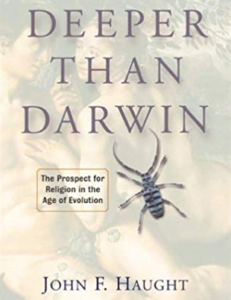 Intelligent life, however, is only one instance of cosmic beauty. We really have no idea of the many forms the cosmic aim towards bringing about beauty might assume with the totality of the universe. Perhaps, then SETI has set its goals too narrowly for theology. What we call intelligent life might turn out to be too trivial a notion to capture what is already “out there,” or the incalculable cosmic outcomes that may yet occur in the future of this unfinished universe. The notion of “beauty,” however, is encompassing enough to anticipate a wide variety of cosmic evolutionary outcomes. As we explore the universe, we should ask not only about the meaning of intelligence, but also about what the existence of beauty implies as far as the essential character of the whole universe is concerned. (p 189)
Intelligent life, however, is only one instance of cosmic beauty. We really have no idea of the many forms the cosmic aim towards bringing about beauty might assume with the totality of the universe. Perhaps, then SETI has set its goals too narrowly for theology. What we call intelligent life might turn out to be too trivial a notion to capture what is already “out there,” or the incalculable cosmic outcomes that may yet occur in the future of this unfinished universe. The notion of “beauty,” however, is encompassing enough to anticipate a wide variety of cosmic evolutionary outcomes. As we explore the universe, we should ask not only about the meaning of intelligence, but also about what the existence of beauty implies as far as the essential character of the whole universe is concerned. (p 189)
God After Darwin: A Theology Of Evolution (2000)
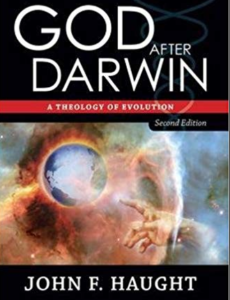 An evolutionary theology encourages us to feel with St. Paul the Spirit of God sharing in nature’s own longing for the consummation of creation. Rather than attributing to God a rigid “plan” for the universe, evolutionary theology prefers to think of God’s “vision” for it. Nature, after Darwin, is not a design but a promise. God’s “plan,” if we continue to use the term, is not a blueprint but an envisagement of what the cosmos might become. A design, as I have noted repeatedly, closes off the future and “clips the wings of hope.” In the beginning, however, instead of design there lies “the Vision.” (p. 190)
An evolutionary theology encourages us to feel with St. Paul the Spirit of God sharing in nature’s own longing for the consummation of creation. Rather than attributing to God a rigid “plan” for the universe, evolutionary theology prefers to think of God’s “vision” for it. Nature, after Darwin, is not a design but a promise. God’s “plan,” if we continue to use the term, is not a blueprint but an envisagement of what the cosmos might become. A design, as I have noted repeatedly, closes off the future and “clips the wings of hope.” In the beginning, however, instead of design there lies “the Vision.” (p. 190)
Science & Religion: From Conflict to Conversation (1995)
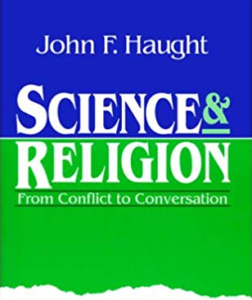 The fundamental unity of science and religion, however, is most explicitly anticipated in the approach that I have been calling confirmation. This fourth way suggests that science and religion, different though they may be, share a common origin in the remote and mysterious fountainhead of a simple human desire to know. Both science and religion ultimately flow out of the same “radical” eros for truth that lies at the heart of our existence. And so, it is because of their shared origin in this fundamental concern for truth that we may never allow them simply to go their separate ways. (p. 203)
The fundamental unity of science and religion, however, is most explicitly anticipated in the approach that I have been calling confirmation. This fourth way suggests that science and religion, different though they may be, share a common origin in the remote and mysterious fountainhead of a simple human desire to know. Both science and religion ultimately flow out of the same “radical” eros for truth that lies at the heart of our existence. And so, it is because of their shared origin in this fundamental concern for truth that we may never allow them simply to go their separate ways. (p. 203)
What is God?: How to Think about the Divine (1986)
But religion is more than a search. For religion is also a confident naming of the dimension of depth. It is the jubilant enunciation of a sense that the depth has broken through into our lives in one way or another. Religion is the symbolic (and at times ritualistic) expression of the shared experience of depth that has made itself transparent to human consciousness. In order for us to undertake the adventurous quest which we have called religion we already need at least some sense of what we are seeking. Otherwise we would not be aroused to seek at all. (p. 22)
*********************************
A Theologian of Renewal by Andrew Cohen
 In this article, Andrew Cohen posts an interview done by Carter Phipps, author of the 2012 book Evolutionaries. In the interview, Phipps sees a man who is clearly a person of the Christian faith, a Catholic, but also one who is “a significant player in a larger spiritual project, one that transcends and includes any specific tradition.” Phipps calls this project evolutionary spirituality, while Haught’s term for the same is evolutionary theology. Regardless of the name, both Phipps and Haught point to the need to reinvent our traditions to fit a radically changed world from the one which formed the traditions of our faith. This article presents a conversation with Haught by one who stands outside the tradition but has been invited in to share ideas. This article which won the Gold Award for Editorial Excellence (2009) from Folio, the leading magazine industry, can be found here.
In this article, Andrew Cohen posts an interview done by Carter Phipps, author of the 2012 book Evolutionaries. In the interview, Phipps sees a man who is clearly a person of the Christian faith, a Catholic, but also one who is “a significant player in a larger spiritual project, one that transcends and includes any specific tradition.” Phipps calls this project evolutionary spirituality, while Haught’s term for the same is evolutionary theology. Regardless of the name, both Phipps and Haught point to the need to reinvent our traditions to fit a radically changed world from the one which formed the traditions of our faith. This article presents a conversation with Haught by one who stands outside the tradition but has been invited in to share ideas. This article which won the Gold Award for Editorial Excellence (2009) from Folio, the leading magazine industry, can be found here.
https://bigthink.com/the-evolution-of-enlightenment/a-theologian-of-renewal
*********************************
AN INTERVIEW WITH JOHN F. HAUGHT with Brie Stoner (Audio)
 In this audio interview Brie Stoner asks Professor Dr. John Haught to expand on some of his ideas and thoughts as introduced in his recent Omega Center blog THE NEW COSMIC STORY, entitled after his new book The New Cosmic Story: Inside Our Awakening Universe. Historians are now expanding their views and examinations into the realm of“Big History” but their focus has primarily been on the objective, outside story. Dr Haught suggests there is an inside story registered in the centers of our subjectivity, interior experience, and relationality, that is equally necessary to understand the cosmos and the awakening universe.
In this audio interview Brie Stoner asks Professor Dr. John Haught to expand on some of his ideas and thoughts as introduced in his recent Omega Center blog THE NEW COSMIC STORY, entitled after his new book The New Cosmic Story: Inside Our Awakening Universe. Historians are now expanding their views and examinations into the realm of“Big History” but their focus has primarily been on the objective, outside story. Dr Haught suggests there is an inside story registered in the centers of our subjectivity, interior experience, and relationality, that is equally necessary to understand the cosmos and the awakening universe.
The Omega Center is an online forum striving to facilitate a deepening of consciousness, conversation, and connection as we seek God in our scientific age. The website is dedicated to education, formation, and inspiration in the converging fields of science and theology and exists to promote and support the work of Ilia Delio, OSF. Ilia Delio, a colleague of John Haught, teaches at Villanova University in Philadelphia. Like John Haught, Dr. Delio has been a frequent participant in science and religion discussions in the Washington, DC area.
The interview can be found here.
https://www.omegacenter.info/interview-john-haught-sept2017
*********************************
Are faith and science contradictory? Or complementary? By Christina Zenner
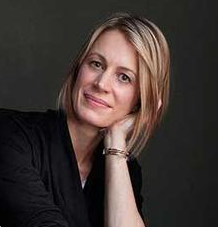 Christiana Zenner is an Associate Professor of Theology, Science, and Ethics at Fordham University in New York. In this article she reviews three books published last year, On Faith and Science by historian Edward Larson and philosopher Michael Ruse, The Image of the Unseen God: Catholicity, Science, and Our Evolving Understanding of God by Thomas Hosinski and The New Cosmic Story by John Haught. Haught’s book is reviewed between the Larson/Ruse book and the one by Hosinski. The order appears quite deliberate, for On Faith and Science presents a broad range of topics from astronomy, physics, neuroscience, geology, biology from a variety of perspectives. Hosinski’s book is explicitly targeted to a Catholic audience while Haught, though certainly Christian, is more broad, ecumenical, even interfaith in his approach. For those of us coming from a Wesleyan background, Haught provides a bridge that is both constructive and inviting. As Zenner states in her closing paragraph, “it is admirable and refreshing that these books ably demonstrate complementary approaches to religion and science with a minimum of vitriol and a standard of appreciable rigor. That such discourses could also surely benefit from sustained attention to non-Christian and nondominant epistemologies remains a perpetual truism”. The article can be found here.
Christiana Zenner is an Associate Professor of Theology, Science, and Ethics at Fordham University in New York. In this article she reviews three books published last year, On Faith and Science by historian Edward Larson and philosopher Michael Ruse, The Image of the Unseen God: Catholicity, Science, and Our Evolving Understanding of God by Thomas Hosinski and The New Cosmic Story by John Haught. Haught’s book is reviewed between the Larson/Ruse book and the one by Hosinski. The order appears quite deliberate, for On Faith and Science presents a broad range of topics from astronomy, physics, neuroscience, geology, biology from a variety of perspectives. Hosinski’s book is explicitly targeted to a Catholic audience while Haught, though certainly Christian, is more broad, ecumenical, even interfaith in his approach. For those of us coming from a Wesleyan background, Haught provides a bridge that is both constructive and inviting. As Zenner states in her closing paragraph, “it is admirable and refreshing that these books ably demonstrate complementary approaches to religion and science with a minimum of vitriol and a standard of appreciable rigor. That such discourses could also surely benefit from sustained attention to non-Christian and nondominant epistemologies remains a perpetual truism”. The article can be found here.
*********************************
ASTROTHEOLOGY: Science and Theology Meet Extraterrestrial Life
Long-time friend of WesleyNexus, Dr. Ted Peters, who co-edits with Robert John Russell the journal Theology and Science at the Francisco J. Ayala Center for Theology and the Natural Sciences at the Graduate Theological Union in Berkeley, California, sent us a galley of his newest book, ASTROTHEOLOGY: Science and Theology Meet Extraterrestrial Life (Cascade Books, an Imprint of Wipf and Stock Publishers, Eugene,Oregon, ISBN: 978-1-5326-0639-7 paperback). As it happens, it fits right in with our theme for this month, cosmology and biblical faith. Actually, Dr. Peters, while being the lead author, serves as editor of this volume, that includes more than a dozen scientists and theologians. It is a massive publication – more than 450 pages – but one can predict that if and when NASA and other space probes do turn up evidence of life elsewhere in the solar system, when the debate manifests itself in the public arena as to the “meaning of it all,” this may well serve as the definitive treatment of the subject. Each chapter – all 24 of them – provides extensive documentation of sources that have framed the discussion up to this point in our history. All of the “big questions” concerning the search for life in the universe are addressed here. Most importantly, Dr. Peters provides the framework for the entire discussion in the initial two chapters. He introduces the field of astrotheology; he identifies four basic sources for a theology of nature; he identifies the four immediate tasks of the astrotheologian; and he outlines squarely the opportunities and difficulties posed by the creative mutual interaction between science and theology. Although the treatment is exhaustive, the authors find that no coherent policy has emerged for planetary exploration or extraterrestrial life. Dr. Peters concludes: “Unfortunately, in our judgment, this SETI version of evolution is over embellished with optimism and disguised ideology. In fact, the concept of evolution through which SETI scientists view their subject matter looks like a secularized myth of gnostic redemption. The task of the astrotheologian is to point this out and to argue for a cleaner science, a science that recognizes the limits imposed by confirmable empirical knowledge.”
The full review of this book can be found here.
*********************************
Coming in September from Discovery & Faith
Genesis 1: Reading from God’s Two Books
A Reconciled Approach to Help Children Understand Science & Creation
As a Christian educator with a background in science, I’ve spent an entire career being frustrated by the way children’s ministry resources deal with the creation story in Genesis 1. Most children’s curricula on Genesis 1 are based on and reflect theologies that oppose science’s understanding of an evolving creation. Rather than building the faith of our children, we know that, in the long run, teaching Genesis 1 in a way that rejects commonly held science actually sets up our children for the failure of their faith. After the age of 15, 3 out of 5 young Christians will disconnect from church life and faith; one of the top reasons is their perception that the church is antagonistic to science.
There is a better way—a reconciled approach that brings together our biblical and scientific understanding of God’s world in the learning experience of a child. Discovery & Faith is pleased to announce the upcoming release of its first curriculum on Genesis 1, Reading from God’s Two Books. This resource is based on “two book theology.” This Christian theological tradition holds that God gave humanity two books of revelation—the book of God’s Words (the Bible) and the book of God’s works (the natural world, which science helps us understand). Since both belong to and ultimately come from God, when properly interpreted, they cannot conflict with each other.
Discovery & Faith has drawn upon this theological approach to create a curriculum that brings hands-on science experiments alongside Bible learning to foster a harmonious experience of faith-and-science. This is a 7-lesson unit, one lesson for each day in the first creation story. There are 4 learning levels: PreK-K, grades 1-2, grades 3-4, and grades 5-6.
While this curriculum doesn’t directly discuss evolution per say (that’s coming in our 2nd curriculum!), it clearly uses language and discusses natural phenomena in ways that are scientifically consistent. It is a great first step for any church that wants to engage in more relevant and lasting discipleship for children.
If you have questions or would like to know more about this curriculum, please contact Jennifer Secki Shields at connect@discoveryandfaith.org
Jennifer Secki Shields is founder & director of Discovery & Faith
*********************************
ASA 73rd Annual Meeting: July 27-30 – Gordon College:
Bioethics, Bio- and Digital Technology. A report from Dr. Paul H. Carr
The 73rd Annual American Scientific Affiliation (ASA) meeting was held in the Ken Olsen Science Center of Gordon College, Wenham, MA, July 27-30, 2018. Rapidly advancing digital and artificial intelligence (AI) technology was the focus. The registration of 350 ASA members from 6 countries set a record for ASA annual meetings. Keynote speaker Francis S. Collins, MD, PhD, spoke to an audience of over 500, including many persons from the nearby communities. In his talk, Dr. Collins addressed, “How should believers view advances in biotechnology?” He was particularly concerned about the ethics of the new gene-editing technique CRISPR, which can permanently modify the human genome. This should not be done. On the other hand, somatic cell gene editing focused on a particular organ should be pursued, as it holds promise for curing many genetic diseases. At the end of his talk, Dr. Collins picked up his guitar and led his large audience in singing “Praise the source of faith and learning.” Other prominent speakers included Douglas A. Lauffenburger, PhD, Ford Professor of Bioengineering and (founding) head of the Department of Biological Engineering at MIT, Noreen Herzfeld, PhD, the Nicholas and Bernice Reuter Professor of Science and Religion at St. John’s University and the College of St. Benedict, and Nigel M. de S. Cameron, PhD, MBA, President-emeritus of the Center for Policy on Emerging Technology in Washington DC. A detailed report on the ASA Conference may be found here, thanks to Dr. Paul H. Carr, our colleague from the IRAS Council.
Abstracts of all the talks, with pdfs of the PowerPoint talks, and videos may be found on the www.asa3.org website and by clicking here.
*********************************
ASA National Capital Section quarterly meeting September 14
The local chapter of the American Scientific Affiliation (ASA) will sponsor a special meeting on September 14 featuring Dr. Jennifer Wiseman speaking on the latest research and discoveries of Exoplanets. The event will be held in the large social hall at the National Presbyterian Church, 4101 Nebraska Avenue, NW, Washington DC 20016, at 6:00 pm. There is a large parking lot to accommodate visitors. Dr. Jennifer Wiseman is an astronomer, author, and much-celebrated speaker. She studies star-forming regions of our galaxy using radio, optical, and infrared telescopes, and currently serves as the Senior Project Scientist for NASA’s Hubble Space Telescope. She also directs the program of Dialogue on Science, Ethics, and Religion (DoSER) for the American Association for the Advancement of Science (AAAS). She received her B.S. in physics from MIT, discovering the comet Wiseman-Skiff in 1987, and continued her studies at Harvard, earning a Ph.D. in astronomy in 1995. She continued her research as a Jansky Fellow at the National Radio Astronomy Observatory and as a Hubble Fellow at the Johns Hopkins University. Dr. Wiseman is a Councilor of the American Astronomical Society and a Fellow of the American Scientific Affiliation, a network of Christians in science. She also serves as a member of the WesleyNexus Advisory Board
*********************************
The Inside Story: Consciousness, Nature, Transcendence
A transdisciplinary conference on Mind, Matter, Meaning and Mysticism
November 9-10, 2018
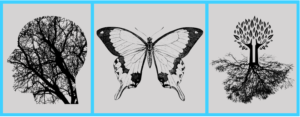 Sponsored by Villanova University, Department of Theology & Religious Studies, Connelly Chair in Christian Theology, the Augustinian Institute, Department of Philosophy, and Halloran Philanthropies.
Sponsored by Villanova University, Department of Theology & Religious Studies, Connelly Chair in Christian Theology, the Augustinian Institute, Department of Philosophy, and Halloran Philanthropies.
Descartes’ famous dictum—I think, therefore I am—gave rise to the modern distinction between mind and matter. But “the inside story” is more complex and thrilling—possibly uniting mind and matter, meaning and mysticism.
Join the in-depth exploration of consciousness, nature, and transcendence, as scientists, philosophers, and theologians ask “What’s on the inside?” Keynote speakers include Philip Clayton, WesleyNexus Advisory Board Member and author of numerous books related to science and religion, including The Predicament of Belief and Mind and Emergence, Ilia Delio, a long time friend of WesleyNexus, past member of the Washington Theological Consortium Science and Religion study group and author of Christ in Evolution, Timothy O’Connor Distinguished Professor of Philosophy at Baylor University in Waco, Texas and author of Theism and Ultimate Explanation: The Necessary Shape of Contingency and Persons and Causes: The Metaphysics of Free Will and Terrence Deacon, neuroanthropologist, Professor of Biological Anthropology at the University of California, Berkeley and author of Incomplete Nature: How Mind Emerged from Matter.
More information on the program can be found here:
https://www1.villanova.edu/villanova/artsci/theology/news_events/inside-story-conference/about.html
